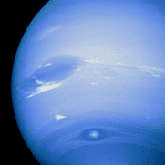Neptune: The Basics
 The eighth planet from the Sun, Neptune was the first planet located through mathematical predictions rather than through regular observations of the sky. When Uranus didn't travel exactly as astronomers expected it to, two mathematicians, working independently of each other, proposed the position and mass of another, as yet unknown planet that could account for Uranus' orbit. Although 'the establishment' ignored the predictions, a young astronomer decided to look for the predicted planet. Thus, Neptune was discovered in 1846. Seventeen days later, its largest moon, Triton, was also discovered. Nearly 4.5 billion kilometers from the Sun, Neptune orbits the Sun once every 165 years, and therefore it has not quite made a full circle around the Sun since it was discovered. It is invisible to the naked eye because of its extreme distance from Earth.
The eighth planet from the Sun, Neptune was the first planet located through mathematical predictions rather than through regular observations of the sky. When Uranus didn't travel exactly as astronomers expected it to, two mathematicians, working independently of each other, proposed the position and mass of another, as yet unknown planet that could account for Uranus' orbit. Although 'the establishment' ignored the predictions, a young astronomer decided to look for the predicted planet. Thus, Neptune was discovered in 1846. Seventeen days later, its largest moon, Triton, was also discovered. Nearly 4.5 billion kilometers from the Sun, Neptune orbits the Sun once every 165 years, and therefore it has not quite made a full circle around the Sun since it was discovered. It is invisible to the naked eye because of its extreme distance from Earth.
Interestingly, due to Pluto's unusual elliptical orbit, Neptune is actually the farthest planet from the Sun for a 20-year period out of every 248 Earth years. Voyager 2 captured this convergence of atmospheric features on Neptune. Neptune has the smallest diameter of our solar system's giant gas planets (including Jupiter, Saturn, and Uranus), so called because they have no solid surfaces. Even so, its volume could hold nearly 60 Earths. Neptune's atmosphere extends to great depths, gradually merging into water and other 'melted ices' over a heavier, approximately Earth-sized liquid core. Neptune's rotational axis is tilted 30 degrees to the plane of its orbit around the Sun. Its seasons last an incredible 41 years. During the southern summer, the south pole is in constant sunlight for about 41 years, and in northern summer, the north pole is in constant sunlight for about 41 years.
Neptune's atmosphere is made up of hydrogen, helium, and methane, the last of these giving the planet its blue color (because methane absorbs red light). Despite its great distance from the Sun and lower energy input, Neptune's winds are three times stronger than Jupiter's and nine times stronger than Earth's. The planet has several rings of varying widths, confirmed by Voyager 2's observations in 1989. Neptune has 11 known moons, six of which were discovered by Voyager 2. The largest, Triton, orbits Neptune in a direction opposite to the planet's rotation direction, and is gradually getting closer until it will collide with the planet in about 10 to 100 million years, forming vast rings around Neptune that will rival or exceed Saturn's extensive ring system. Triton is the coldest body yet visited in our solar system; temperatures on its surface are about -235 C. Despite the deep freeze, Voyager 2 discovered great geysers of gaseous nitrogen on Triton.
Fact Credit
NASA Headquarters


